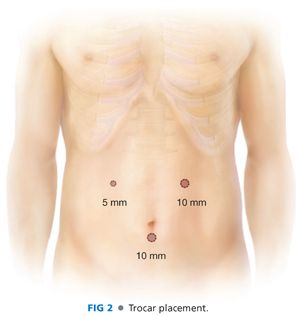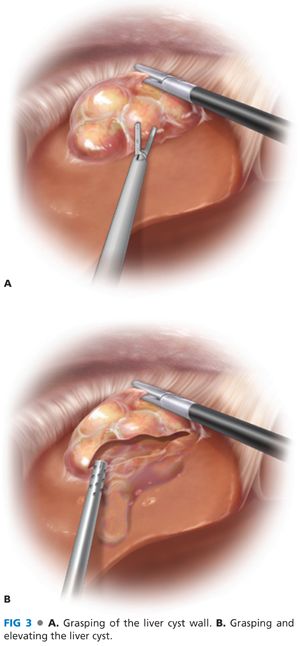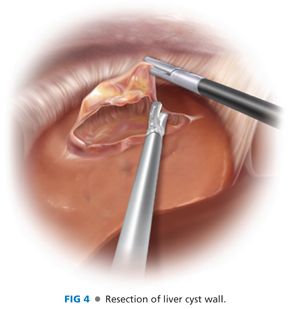■ Symptoms are more common with right-sided cysts.
■ Ultrasound-guided percutaneous cyst aspiration has minimal role in treatment of symptomatic cysts, as the recurrence rate is high and as rapid as 2 weeks.
■ If symptoms persist after needle aspiration, the cyst is not the likely cause and other diagnoses should be investigated.
■ Alternatively, if symptoms resolve after aspiration and return with recurrence of the cyst, definitive treatment of the cyst is indicated.
■ Indications for intervention include pain, jaundice, infection, and hemorrhage. Occasionally, compression results in portal hypertension and indicates resection is appropriate.
■ Most cysts that are incidentally identified do not warrant resection, provided the cyst lacks features of malignant potential. These features include septations; heterogenous attenuation; and a thickened, enhancing cyst wall.
■ Complications are rare but include intracystic hemorrhage, biliary obstruction due to compression, cyst rupture, and cyst torsion. Bacterial infection leading to symptoms is occasionally observed.
IMAGING AND OTHER DIAGNOSTIC STUDIES
■ Because most hepatic cysts are asymptomatic, they are most frequently detected on imaging of the abdomen obtained for other indications.
■ Laboratory tests of liver enzymes (aspartate aminotransferase [AST], alanine aminotransferase [ALT], bilirubin, alkaline phosphatase) and tumor markers (carcinoembryonic antigen [CEA], carbohydrate antigen 19-9 [CA 19-9]) and serologies (hydatid)
■ Ultrasound scanning demonstrates a rounded, anechoic intrahepatic mass with good thorough transmission and an imperceptible wall.
■ Computed tomography shows a benign hepatic cyst as a homogenous lesion of low attenuation with no enhancement of the wall or content following administration of contrast.
■ Magnetic resonance scanning diagnostic criteria are a homogenous lesion with low attenuation in T1 weighted images and a very high–signal intensity on T2 weighted images.
■ Importantly, neuroendocrine and sarcoma hepatic metastases occasionally appear cystic.
TECHNIQUES
Fenestration
Preoperative Planning
■ Prior to operation, the patient should be counseled regarding the pros and cons of laparoscopic versus open surgery.
■ Although the risk of infection after liver surgery is low, antibiotic prophylaxis significantly reduces the risk of postoperative infection.
Laparoscopic Fenestration
■ Laparoscopic cyst fenestration has evolved to be the first-line surgical approach for symptomatic cysts.
■ Port placement. A three-port laparoscopic technique is used (FIG 2): camera (30 or 45 degree), grasper for the cyst wall, and cutting instrument (cautery, Harmonic scalpel, or scissors). One of the ports should be 10 mm for clip application.

■ Grasping of cyst. The cyst can be elevated with a grasper once it has been punctured through the exposed wall immediately adjacent to the liver parenchyma by insertion of a cutting instrument. The contents are drained and sent for analysis (FIG 3).

■ Resection of cyst wall. A wide excision of the cyst wall is performed using bipolar electrocautery or Harmonic shears. The intent is to excise the entire free wall and not to venture into the hepatic parenchyma (FIG 4).

■ Removal of resected cyst. The resected cyst wall is removed in an endoscopic retrieval bag and the remnant cyst epithelium inspected.
■ Obliteration of remnant cyst epithelium. Obliteration of the remnant cyst wall against the hepatic parenchyma should be treated with electrocautery, argon beam coagulation, or topical sclerosant.
■ Omentoplasty
Stay updated, free articles. Join our Telegram channel

Full access? Get Clinical Tree








